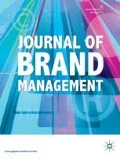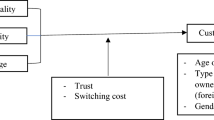Abstract
Over the past 20 years brand loyalty has been an important topic for both marketing practitioners and academics. While practitioners have produced proprietary brand loyalty audit models, there has been little academic research to make transparent the methodology that underpins these audits and to enable practitioners to understand, develop and conduct their own audits. In this article, we propose a framework for a brand loyalty audit that uses a tri-dimensional approach to brand loyalty, which includes behavioural loyalty and the two components of attitudinal loyalty: emotional and cognitive loyalty. In allowing for different levels and intensity of brand loyalty, this tri-dimensional approach is important from a managerial perspective. It means that loyalty strategies that arise from a brand audit can be made more effective by targeting the market segments that demonstrate the most appropriate combination of brand loyalty components. We propose a matrix with three dimensions (emotional, cognitive and behavioural loyalty) and two levels (high and low loyalty) to facilitate a brand loyalty audit. To demonstrate this matrix, we use the example of financial services, in particular a rewards-based credit card.

Similar content being viewed by others
References
DeWitt, T., Nguyen, D.T. and Marshall, R. (2008) Exploring customer loyalty following service recovery: The mediating effects of trust and emotions. Journal of Service Research 10 (3): 269–281.
Russell-Bennett, R., McColl-Kennedy, J.R. and Coote, L.V. (2007) The relative importance of perceived risk, involvement and satisfaction on brand loyalty in a business services setting. Journal of Business Research 60 (12): 1253–1260.
Bandyopadhyay, S. and Martell, M. (2007) Does attitudinal loyalty influence behavioral loyalty? A theoretical and empirical study. Journal of Retailing and Consumer Services 14 (1): 35–44.
Rundle-Thiele, S. and Bennett, R. (2001) A brand for all seasons? A discussion of brand loyalty approaches and their applicability for different markets. Journal of Product and Brand Management 1 (10): 25–37.
East, R., Gendall, P., Hammond, K. and Lomax, W. (2005) Consumer loyalty: Singular, additive or interactive? Australasian Marketing Journal 13 (2): 10–27.
Ajzen, I. (2001) Nature and operation of attitudes. Annual Review of Psychology 52: 27–58.
Oliver, R.L. (1999) Whence consumer loyalty? Journal of Marketing 63 (Special issue): 33–44.
Härtel, C.E.J., Russell-Bennett, R., Lloyd, S. and Russell, K. (2008) Heart vs mind: What functions do emotional and cognitive loyalty serve? Proceedings of the Sixth International Conference on Emotions and Organizational Life; 17–19 July, Fontainebleau, France.
Allen, N.J. and Meyer, J.P. (1990) Measurement and antecedents of affective, continuance and normative commitment to the organization. Journal of Occupational Psychology 63: 1–8.
Hammond, K., East, R. and Ehrenberg, A. (1996) Buying More and Buying Longer: Concepts and Measures of Consumer Loyalty. London: London Business School.
ACNielsen. (2009) ACNielsen homescan/I-scan loyalty & repeat, http://asiapacific.acnielsen.com/products/crs_iscan_loyalty.shtml, accessed 10 July 2009.
TNS Conversion Model. (2009) Conversion model library, http://www.conversionmodel.com/content.asp?page=library_intro&head=library&leftpanel=library&hash, accessed 10 July 2009.
Jackson, C. (2006) Driving brand loyalty on the web. Design Management Review 17 (1): 62–67.
Dick, A.S. and Basu, K. (1994) Customer loyalty towards an integrated framework. Journal of the Academy of Marketing Science 22 (2): 99–113.
Kotler, P., Brown, L., Adam, S., Burton, S. and Armstrong, G. (2007) Marketing, 7th edn. Sydney, Australia: Pearson Education.
Rauyruen, P. and Miller, K.E. (2007) Relationship quality as a predictor of B2B customer loyalty. Journal of Business Research 60 (1): 21–31.
Holbrook, M.B. (2006) Consumption experience, customer value, and subjective personal introspection: An illustrative photographic essay. Journal of Business Research 59: 714–725.
Fullerton, G. (2003) When does commitment lead to loyalty? Journal of Service Research 5 (4): 333–344.
Uncles, M.D., Dowling, G.R. and Hammond, K. (2003) Customer loyalty and customer loyalty programs. Journal of Consumer Marketing 20 (4/5): 294–317.
Kardes, F.R. (2002) Consumer Behavior and Managerial Decision Making. New Jersey: Prentice Hall.
Keers, H. (2008) Getting to the point of rewards. The Age, 30 November: 8–9.
Worthington, S. (2008) The regulation of payment cards in Australia: Recent changes and their implications. Journal of Payment Strategy and Systems 2 (2): 205–217.
Worthington, S. (1999) Branding and relationship issues in affinity and co-branded credit cards. Journal of Brand Management 6 (3): 188–198.
Worthington, S. (2001) Affinity credit cards: A critical review. International Journal of Retail & Distribution Management 29 (11): 485–508.
Acknowledgements
The research in this paper was jointly funded by the Australian Research Council (Grant no. LP0455372) and Colmar Brunton Research.
Author information
Authors and Affiliations
Corresponding author
Additional information
2(Associate Professor) is a marketing academic with the school of Advertising, Marketing and Public Relations at Queensland University of Technology. She holds a PhD in brand loyalty and has published in international journals such as Journal of Business Research, Industrial Marketing Management, Journal of Brand Management, Journal of Product and Brand Management and Journal of Services Marketing. Rebekah has worked with organisations across a variety of service industries in Australia including Sensis, Brandaide, Australian Breastfeeding Association, Brisbane Lions, Queensland Health, Queensland Rail, Telstra and Westpac.
Rights and permissions
About this article
Cite this article
Worthington, S., Russell-Bennett, R. & Härtel, C. A tri-dimensional approach for auditing brand loyalty. J Brand Manag 17, 243–253 (2010). https://doi.org/10.1057/bm.2009.24
Received:
Revised:
Published:
Issue Date:
DOI: https://doi.org/10.1057/bm.2009.24




